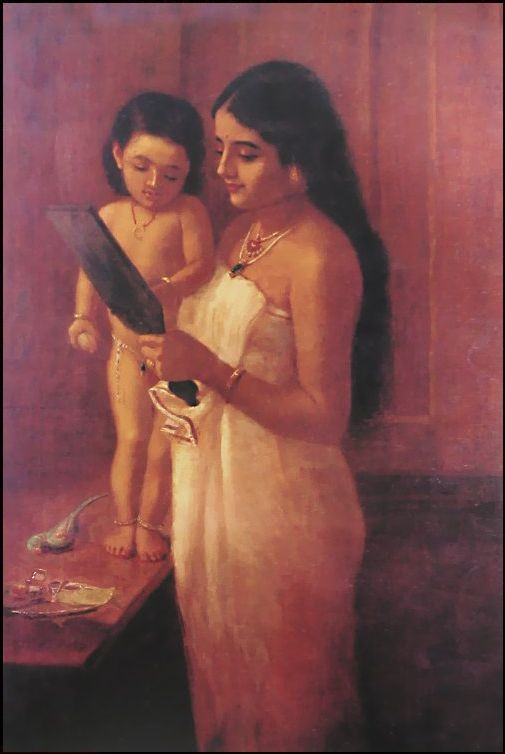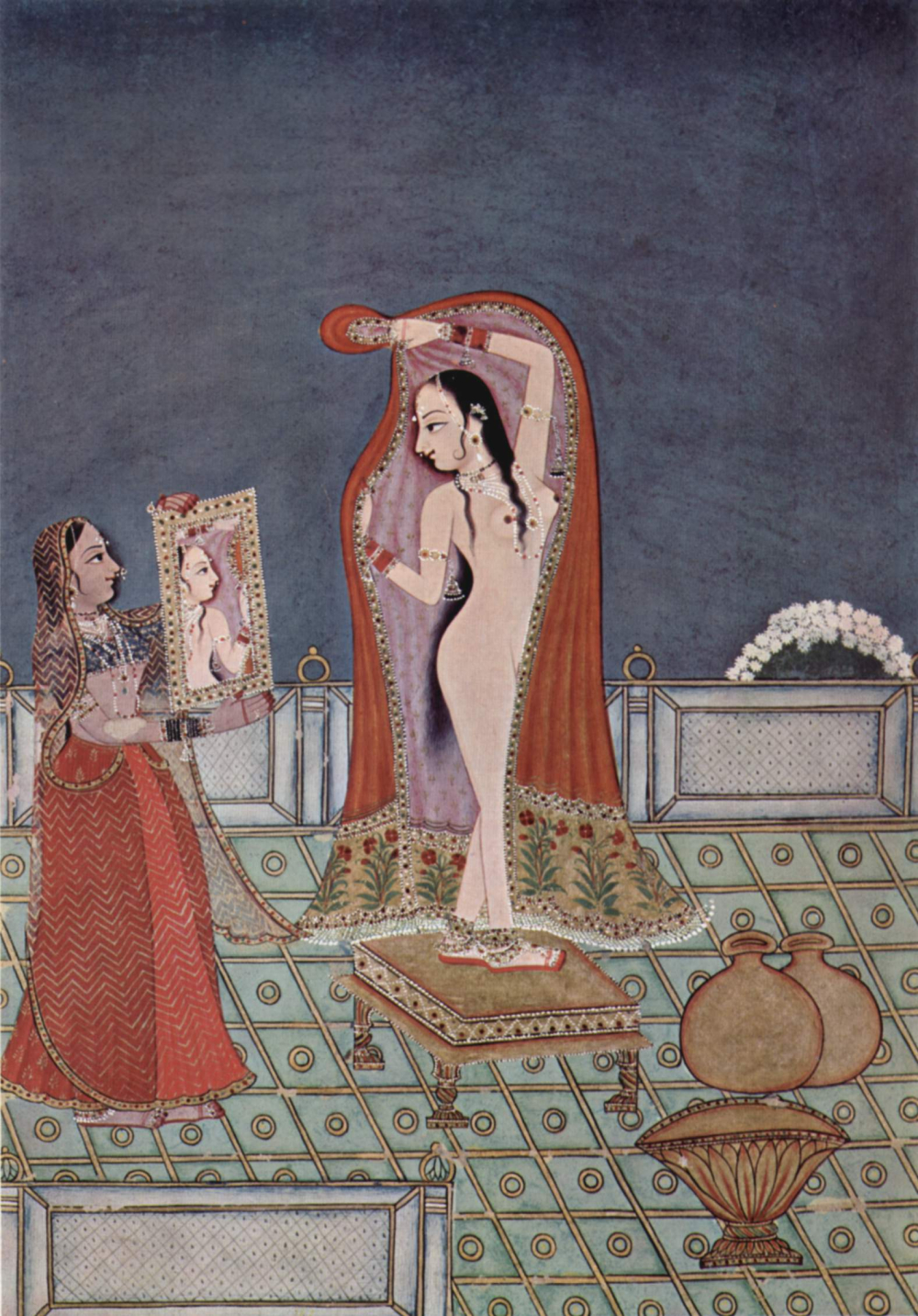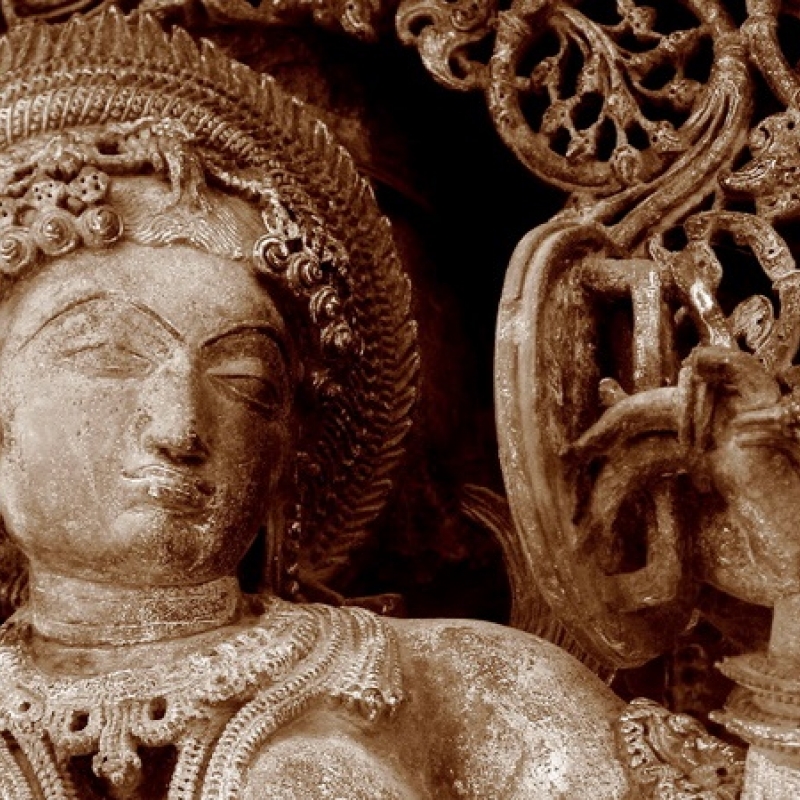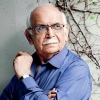There is much in our way of seeing and rendering mirrors that is full of great fascination. Prof. B.N. Goswamy writes about the mirror as something that both reveals and conceals at the same time, and the Persian legend of Alexander’s ironsmith having invented the mirror. (In pic: Darpana, one of the surasundaris on a temple in Belur, Halebidu in Karnataka; Photo courtesy: Soham Banerjee/Wikimedia Commons)
This article appeared originally in The Tribune, Chandigarh and is reproduced here with permission.
At the time that I write this, I should have been in Bombay, attending an international conference. But, thanks to the kinds of things one constantly rubs against in our land—"fractured" railway tracks, interminable waits at airports, garbled communications, cancelled flights, and now ground fog, to name our current woes—I am still in town, trying to make sense of things. It is not easy.
However, back to the conference, which was on ‘Shringara’. Somewhat light in weight as the theme might sound, especially for an international meet, I was looking forward to being part of it. For the range of papers due to be presented was truly varied, and I remember being surprised—from the titles circulated—by how differently, and thoughtfully, the subject was going to be approached by different scholars. I do not know a great deal about it but, "The Body" being currently the subject of animated discourse everywhere, there was much stimulation of mind the conference promised, even if the focus in it was to be on personal adornment.

The paper that I was going to present at the conference was on "The Mirror in Indian Art and Thought". There is much in our way of seeing and rendering mirrors that is full of great fascination: the mirror as something that both reveals and conceals at the same time; the mirror as a reminder; the mirror as a metaphor for illusion; the mirror as a means of self-realisation. But much of this may be too academic, and I have no intention of forcing upon the reader what I was going to say in this strain; in any case, without the necessary accompanying visual material, it may not even make any sense. But a few thoughts, things that I knew—and confirmed for myself—or picked up in the course of working on the paper, I do wish to share.
Thinking of mirrors in Indian art, among the first images that come to mind are of those dusky beauties in Ajanta at their elaborate toilettes, or the sundaris of Khajuraho, regarding themselves in hand-held mirrors. But it is not as a highly polished, reflecting surface made of metal alone that one thinks of, when one thinks of a mirror in ancient India. One also knows that it figures in the list of the eight auspicious objects, the ashta-mangalas, that feature repeatedly in those early Jaina texts and paintings.
Also read | Who are the 16 Surasundaris on Indian Temples?
What is it that makes the mirror auspicious, one wonders? Why is it that Tulasidas speaks of the need to cleanse "the mirror of the heart" with the "pollen taken from the lotus-feet" of the guru? What is it that is reflected in it? The self, more than a mere face? I remember seeing, a long time ago, a short documentary film on the temples of Kerala which ended with showing a small village "temple" somewhere, built in the traditional manner, in which, inside the innermost chamber, there is no sacred image: all that hangs there is a mirror. The devotee enters the somewhat dark and secluded chamber, and sees only himself. Clearly, there is a statement here, but what is it? Is the mirror an invitation not to look at, but to reflect upon, oneself? Discover for oneself the divinity that resides within?
Also see | Art N Soul: Chamba Rumal—Reviving a Languishing Craft
In the matter of mirrors, there are of course more playful things, among them a whole range of verses—some of them of exquisite delicacy—woven around the mirror, both as a metaphor and as an intermediary. And there are some wonderful images, especially in the area of painting: lovers nestling against each other and gazing at themselves in mirrors, Radha surprised by "another feflection" in her mirror, innocently unaware that Krishna has silently crept up behind her; a nayika waiting for her lover, running a last-minute check on her face by looking into her thumb-ring aarsi-mirror; a ragini adjusting an ear-ornament seated inside a sheesh mahal chamber; and so on. But each time, one discovers something new, or different, in these images, for the artist is seldom satisfied by a simple reproduction of a face in an image.

In this genre, one of the more engaging pictures I chanced recently upon was a delicate Mughal work, sowing the great Alexander seated surrounded by his courtiers. One of them stands holding a mirror in which the conqueror sees his own reflection. The reference of course is not to Alexander’s narcissism, but to the Persian legend according to which it is to him that the world owes the invention of a mirror. The conqueror, who is always presented in the Islamic tradition as a thinker or a philosopher, wished, it is said, to see not only reality but also the illusion of reality. Only one craftsman in Alexander’s employ had the mental resource to attempt such a thing, an ironsmith by the name of Rassam. He worked long and hard on a piece of iron, polishing and burnishing it, till a reflection could be seen in it. (Hence the name aahana—from aahan, iron, of which the Persian/Urdu word, aaina, is a corruption.) In a vignette at the bottom of this Mughal painting, one sees a group of craftsmen toiling hard on sheets of metal.
A Conundrum
As so often, one turns to Amir Khusro. That great and playful poet has a paheli or conundrum on the subject of a mirror (which works better in recitation than in reading).
Farsi seekhi, aai na
(Persian I tried to learn, but could not)
Turki dhoondhi, paai na
(Turkish I tried to find, but could not)
Hindi boloon, aar si aavay
(Hindi I can speak, but with some embarrassment)
Khusro kahai, na koi bataavay
(Let Khusro tell it, no one else!)
One sees, of course, that he is playing here with the words for a mirror in Persian (aaina), Turkish (paaina), and Hindi (aarsi), breaking each up to yield different meanings.
This article has been republished as part of an ongoing series Art N Soul from The Tribune.













